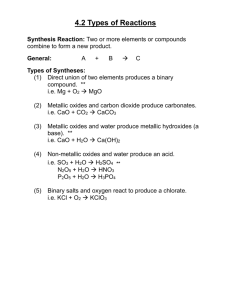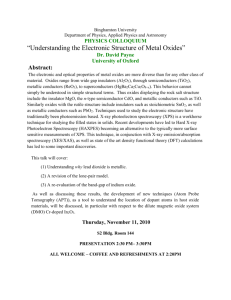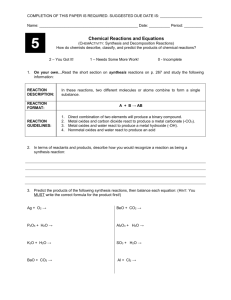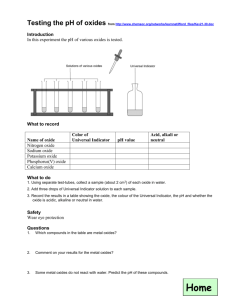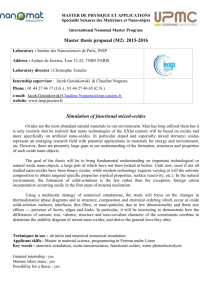ppt
advertisement
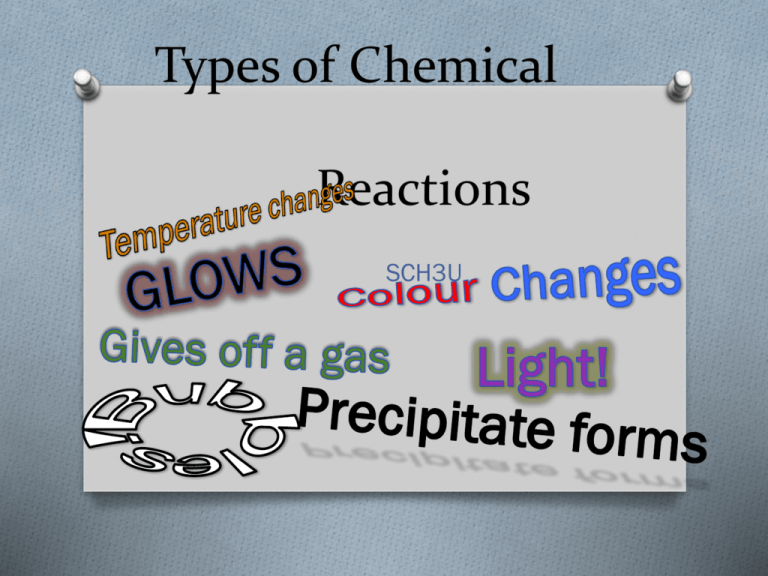
Types of Chemical Reactions SCH3U Success Criteria O By the end of this class you should: O Be able to classify a reaction as synthesis, decomposition, single displacement, double displacement, combustion or neutralization. O Be able to predict the products of synthesis and decomposition reactions. Synthesis (Combination) Reaction O Two or more reactants combine to form one product A + B AB Examples of synthesis O Metal + oxygen → metal oxide O 2Mg(s) + O2(g) → 2MgO(s) O Nonmetal + oxygen → O C(s) + O2(g) → nonmetallic oxide CO2(g) O Metal oxide + water → O MgO(s) + H2O(l) → metallic hydroxide Mg(OH)2(aq) O Nonmetallic oxide + water → O CO2(g) + H2O(l) → O Metal + nonmetal → O Mg(s) + Cl2(g) → acid H2CO3(aq) (one more oxygen) ionic compound (salt ) MgCl2(s) O A few nonmetals combine with each other. O 2P(s) + 3Cl2(g) → 2PCl3(g) Oxides • When an element combines with oxygen an oxide is formed • Metals react with oxygen to form metal oxides • Metal oxides • are always solids • react in water to form basic solutions • are also called basic oxides Metal Oxides - Example 2 Ca(s) + O2(g) 2 CaO(s) metal oxide CaO(s) + H2O (l) Ca(OH)2(aq) basic solution metal hydroxide Oxides • Non-metals react with oxygen to form non-metal oxides • Non-metal oxides • are often gases or liquids • react in water to form acidic solutions • are also called acidic oxides Non-metal Oxides - Example N2 (g) + 2 O2(g) 2 NO2 (g) non-metal oxide 3 NO2 (g) + H2O (l) 2 HNO3(aq) + NO (g) acidic solution Summary of Predicting Synthesis Reactions 1. Metal oxides react with water to form metal hydroxides (bases) 2. Non-metal oxides react with water to form oxyacids (you just add 1 more oxygen to the oxide to form it’s oxyanion) 3. A metal and non-metal combine to form an ionic compound (a salt) 4. Some non-metals will combine to form covalent compounds. Decomposition Reaction O A single reactant is decomposed/broken down into two or more products. AB A + B Examples O O Metallic carbonates, when heated, form metallic oxides & CO2(g). MgCO3(s) → MgO(s) + CO2(g) O Most metallic hydroxides, when heated, decompose into metallic oxides and water. Ca(OH)2(s) → CaO(s) + H2O(g) O Metallic chlorates, when heated, decompose into metallic chlorides and oxygen. 2KClO3(s) → 2KCl(s) + 3O2(g) O Some acids, when heated, decompose into nonmetallic oxides and water. O O H2SO4(aq) → H2O(l) + SO3(g) Some oxides, when heated, decompose. O O 2HgO(s) → 2Hg(l) + O2(g) Some decomposition reactions are produced by electricity(electrolysis). O O 2H2O(l) → 2H2(g) + O2(g) 2NaCl(l) → 2Na(s) + Cl2(g) Summary of Decomposition Reactions 1. 2. 3. 4. 5. All binary compounds break down into their elements Metal carbonates decompose when heated to form metal oxides and carbon dioxide Chlorates decompose when heated to form chloride compounds and oxygen gas Bases (metal hydroxides) decompose when heated to a metal oxide and water Oxyacids decompose when heated to a nonmetal oxide and water
